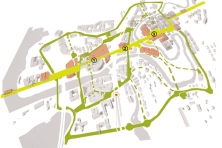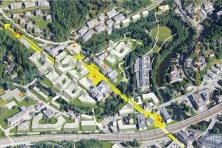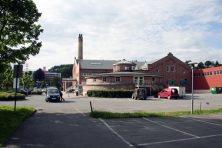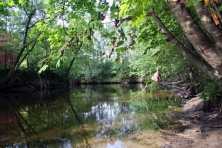Elasti-City
Bærum (NO) – Mentionné
DONNÉES DE L'ÉQUIPE
Représentante d'équipe : Elisabeth Sjodahl (SE) – architecte
Collaborateur : Alejandro Navarrete (ES) – architecte
WORKSONLAND, Grini Mølle Grinidammen 10, 1359 Eiksmarka – Norge
+47 99 86 67 34 – elisabeth.sjodahl@gmail.com – www.worksonland.com
Voir la liste complète des portraits ici
Voir la page du site ici

E. Sjodahl et A. Navarrete
INTERVIEW (en anglais)
1. How did you form the team for the competition?
This Europan competition was made with a small team composed of Elisabeth Sjodahl as author and Alejandro Navarrete as contributor.
2. How do you define the main issue of your project, insisting on how you answered on this session main topic: adaptability and urban rhythms?
The main goal of the project is to bind together a rich yet complex context: the different city districts, topography and nature, history and expanded time frames...
ELASTIC AXIS is a fluctuating spine linking Hamang to the city of Sandvika and the fjord. Two interconnected rings, integrating public transport, a mixture of programs and public spaces bind Hamang with East and West Sandvika.
ELASTIC RIVERBEDS is the design strategy to manage the fluctuations in water levels and to improve flood protection. Sequences of terraced flexible and permeable spaces enhance the retention capacity along the watercourse and adaptability to changing conditions. The elder buildings on site accommodate new uses and the new mixed scale blocks allow future adaptation in density and program.


3. How did this issue and the questions raised by the site mutation meet?
The question of adaptability is always present in a project where the proposal seeks an answer to the site. In this case one of the fundamental factors to take into account is the presence of water as resource and threat.


4. Have you already treated this issue previously and could you present some reference projects that inspired yours?
We dealt with the direct contact to water and its possibilities and threats in earlier projects such as the competition proposals for the harbor of Ålesund (NO) where the landscape is restructured, and the urban development of the river village Floda (SE); there, different topographical levels with different programs are elaborated in order to face the unpredictable water level. The water related works of Kelly Shannon were also of great inspiration.
5. Today –within the era of an economic crisis and sustainability– the urban-architectural project should reconsider its production method in time; how did you integrate this issue in your project?
The question of time and rhythm of changes related to the economy is relative to each place. We know that there will be changes in the economy but it is always very difficult to foresee the sequences of these changes in time. In the case of urban planning the time frame is so wide that it should be able to host the unpredictable, which is a big challenge. In terms of resources the interesting thing is to make as much as possible out of as little as possible. Therefore, it is important to read the site carefully in order to take advantage of what is already there and include it in the project.
This project seeks to give a long time perspective in its proposal with a clear structure that allows changes over time and include the qualities of the Sandvika river.
6. Is it the first time you have been awarded a prize at Europan? How could this help you in your professional career?
Elisabeth Sjödahl was awarded a prize at Europan 6 on the site of Järfälla (SE), outside Stockholm.